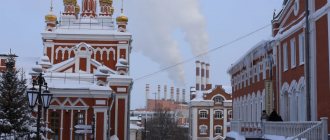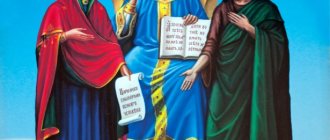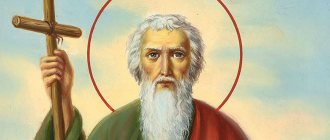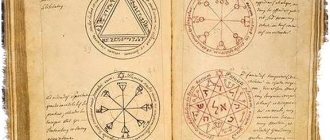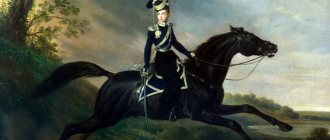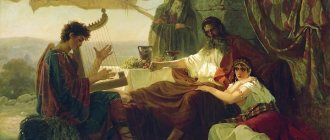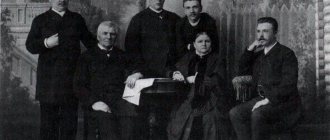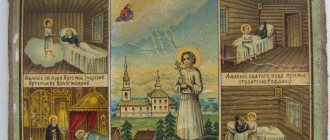This term has other meanings, see Three Kings (meanings).
Three Magi, Byzantine mosaic, c. 565, Sant'Apollinare Nuovo, Ravenna, Italy (restored in the 18th century). Here, Byzantine art typically depicts the Magi in Persian clothing, which includes capes and Phrygian caps. On a Greek icon In Veronese's interpretation
Three kings
, also
magicians
(Greek μάγοι),
Magi
- in the Western European tradition of
Melchior
,
Kaspar
(
Gaspar, Kasper
),
Valtasar
[1] [2] (
Balthazar, Baltazar [3], Beltazar [3], Valtazar, Waltzar, Valtasar
) - people who brought gifts to the baby Jesus Christ born in Bethlehem (see the worship of the Magi). Their names and rank are not mentioned in the Gospel; the tradition arose in the Middle Ages. The idea of the Magi as eastern kings finally took shape in medieval Europe starting from the 9th century[2].
Story
Magi in the east were called magicians, priests, and scientists. Biblical scholars suggest that they came from Babylon, Mesopotamia, and possibly India, since they followed the Star of Bethlehem for at least five months. Using this unusually bright star, the Magi made a prophecy about the birth of the Messiah in Bethlehem, and found the manger where Jesus Christ was born[4]. This star was seen - according to the Gospel legends - by Joseph and Mary, the shepherds, and all the residents of the small town of Bethlehem, 7 km from Jerusalem. To prove the reality of the celestial effect from the star, which is extraordinary in brightness and color, biblical scholars cite the calculations of astronomer Johannes Kepler, who wrote about the conjunction of Jupiter and Saturn in the constellation Pisces with the synchronous approach of Mars to them. The phenomenon of a bright star repeats itself, according to Kepler, after 794 years.
Balthasar and the image of the Tsar
The name Balthasar (Balthasar) was first mentioned in ancient Babylon. At that time it belonged to the biblical King who ruled the city. And it was under him that Babylon fell from the Persians. After this, the phrase appeared and took root - Belshazzar’s feast, which is used to denote carefree fun, after which inevitable disaster will strike.
According to historical data, Belshazzar was not the direct king of Babylon, since he was at the helm periodically; and most often when his father went on campaigns.
According to the scriptures, during the feast Belshazzar used dishes that he personally stole from the destroyed temple of God. For this offense, called an insult by the Supreme Court, Belshazzar was punished by God. One day, while walking, he saw inscriptions supernaturally appear on the wall - they seemed to appear from the movements of a human hand, but no one was nearby at that moment. The inscription was as follows: counted (mene), weighed (tekhel), divided (farrekh) .
Thus, after reading this inscription, the king’s life cycle came to its logical conclusion.
Traditions
Evangelist Matthew does not write about the number of Magi and their rank. Based on the number of gifts brought, it was assumed that there were three of them. For the first time the Magi were called kings by Saint Caesarius of Arles[1]. The Venerable Bede appears with their names - Caspar, Melchior
and
Belshazzar
. He also described their appearance and age: Melchior was a bearded old man, Caspar was a beardless youth, Belshazzar was dark and completely bearded[2][6][7].
The Magi began to be portrayed as representatives of three different ages of man and three different parts of the world. Despite some differences, it is generally believed that Melchior was an old man and the king of Arabia, Caspar was a youth and the king of Tarsus, Belshazzar was middle-aged and the king of Ethiopia[8]. The Magi brought the baby a gift of gold as a gift to a king, incense as a gift to God, and myrrh as a gift to a person who would be buried.
There are Greek versions of their names ( Appellikon
,
Amerin
and
Damaskon
) and Jewish (
Magalat
,
Galgalat
and
Serakin
).
There are legends about the fourth Magi, whose name is Artabanus
(as the brother of the Persian king Darius).
In early manuscripts Belshazzar is called Bethesarei
.
In the Syrian Church there is a legend about 12 wise men who arrived in Jerusalem with a huge retinue[2].
Balthazar the demon
Balthazar is a demon born from the union of an ordinary earthly man and a she-devil of the element of Fire. To be more scrupulous, Balthazar is not even a demon, but a demonic creation, a concentrate of Evil. His character is malicious and quarrelsome, and his essence is treacherous. Either he is in the guise of a malevolent demon with a disgusting appearance (dark red face, hooves and horns), or he appears to those around him as the most banal person.
He is the lord of mirages and transformations, lies and curses. He loves forgery, intrigue and squabbles. He is prone to emotional instability, and he is overwhelmed by not the brightest feelings - violent outbursts of rage alternate with no less monstrous lust and debauchery. All this terrifies his opponents, and makes him virtually invulnerable. You can count on that after this you will no longer be bothered by the question of why this demon is perceived as so insidious and malicious.
Reverence
In the Catholic Church, the memory of the Three Magi is celebrated on the feast of Epiphany (January 6, a day off in some Catholic countries). The holiday received the name in the Catholic Church - the Feast of the Kings (Festum regum) or the Feast of the Three Kings (Festum trium regum)[9].
The Three Magi are considered the patrons of travelers and therefore their names were often included in the names of hotels (formerly inns), for example, fr. Hotel Les Trois Rois - Hotel "Three Kings", German. Zur Krone - “At the crown”, German. Zur Stern - “At the Star”, German. Zu Drei Königen - "At the Three Kings."
LiveInternetLiveInternet
Quote from the message "beautiful woman"
Read in full In your quotation book or community!
Whether they were shamans, shepherds or fire worshipers is unknown. However, it is to them that tradition attributes the glory of the first people who recognized Christ as the Savior.
Pagan, aka king
Cancer of the Three Magi
One of the most famous Christian shrines in the world - the shrine of the Three Magi - is located behind the altar of Cologne Cathedral. She is the memory of those who, according to legend, came with gifts to worship the infant Christ. Because of the ability to recognize the Savior of the world in a baby, in the Middle Ages they were called kings (or kings).
At first glance, the glorification of pagans by the church, such as Caspar, Melchior and Balthasar, is paradoxical. The Western European world knows them by these names. Magi - the definition given by the Slavic tradition. In the classical literature of the ancient period, they were also called sorcerers, who were fire worshipers, soothsayers, shamans, and did this professionally.
However, theologians try not to focus on such details, considering the arrival of magicians in Bethlehem as a symbol of the admiration of the pagan world for the Christian world, the advent of a new era in the history of civilization.
Why kings?
Cologne Cathedral
From the point of view of the church, it is completely unacceptable to mention Caspar, Melchior and Balthasar as Magi - the attitude towards the latter in the Catholic tradition was sharply negative. This is how they received the status of kings. It was believed that only those sitting on the throne possessed the highest wisdom, since both their rank and insight were a priori of divine origin.
It is appropriate to note that their names and rank are not mentioned in the Gospel, therefore, for example, the Orthodox Church does not consider them kings, did not give them names and did not include them in the doctrine, unlike the Catholic Church. The appearance of a cathedral in Catholic Cologne, which became the tomb of the Three Magi, determined the special status of the city. It turned out to be a European spiritual center, where services could be conducted by archbishops, some of whom could become (and did become) pontiffs.
Catholic tradition calls the three wise men kings. In memory of them, a special service is held on January 6.
Wandering of the relics
According to legend, the relics of the Magi were found by Empress Helen, they were first placed in Constantinople, and in the 4th century they were transferred from there by Bishop Eustorgius to Mediolan (later Milan). In 1164, Frederick Barbarossa captured Milan and transferred the relics to Cologne, at the disposal of Archbishop Rainald von Dassel. In Cologne, a shrine of the Three Magi was built for the relics, and to house it, the construction of the Cologne Cathedral was undertaken, according to the plans of the creators - the most majestic cathedral in Western Europe at that time.
Kings represent continents
The Gospel tradition determines the number of wise men by the number of gifts they brought. This contained two ideas: generational and geopolitical. As the iconographic type developed, the Magi began to be depicted as representatives of three different human ages (Balthasar - a youth, Melchior - a mature man and Caspar - an old man) and three different parts of the world (Balthasar - a Moor, Africa; Melchior - a white man, Europe; Caspar - with with oriental features or in oriental clothing; Asia). There is another interpretation: Caspar represents Africa, Melchior – Europe, Balthasar – Asia.
In any case, their homelands were different continents. This means that representatives of different generations of the world known at that time ended up in Bethlehem.
Meanwhile, an inventory examination of the relics, undertaken in the 19th century, showed that the shrine contained the remains, and incomplete ones, of two people, which is not clear. However, this is not all mysteries. Three skulls. They belong to men 25-30, 10-12 and 50 years old, which is strange. It is unlikely that one of the Magi was a teenager.
The meaning of the relic and its embodiment
Monument to Reinhold von Dassel in Hildesheim
The relics of saints have always attracted crowds of pilgrims and, accordingly, cash flows to certain churches, valuable for their unique relics.
At one time, work on the triple reliquary was entrusted to Nikolai Verdunsky, a famous goldsmith in Europe. He was also the developer of raki. Each of the three kings rests in a separate sarcophagus.
In general, the pyramidal structure (two sarcophagi below and one above them) resembles a basilica. Its width is -110, height - 153, length - 220 centimeters. The design contains its own symbolism - the embodiment of the idea of the trinity of God.
Distributed along the walls of the sarcophagus are 74 relief figures made of gilded silver, depicting prophets and apostles, as well as scenes from the life of Christ. Archbishop Rainald and King Otto IV, who donated a considerable sum for the construction of the cathedral, and other persons directly related to the construction of the temple are depicted.
The work is considered the main shrine of the city, including for mercantile reasons: at least a thousand precious stones and pearls, including antique cameos and gems, were used to decorate the reliquary.
The high real and artistic value was the reason that during the French occupation during the Napoleonic Wars (late 18th - early 19th centuries) and the annexation of the Rhineland, the shrine, along with other cathedral treasures, a library and an archive, was packed into boxes and transported to a safe place, to the monastery in Arnsberg. The shrine was just as carefully hidden in the secret cellars of one of the castles in July 1942.
The names of the three kings became part of the everyday symbolism of the Catholic world. On religious holidays, on the top of the door frame at the entrance to the house, the priests chalked C + M + B, which meant the Latin expression Christus mansionem benedicat (“Christ bless this house!”). The letters C + M + B were accompanied by a cross. At the same time, the clergy said: “Let us not forget that our whole life belongs to the One who redeemed us in this sign.”
White chalk symbolized the purity of the thoughts of Jesus Christ. Residents of Catholic countries covered the signs on the door with visors for as long as possible, protecting them from bad weather. The people, who had not freed themselves from the pagan heritage, perceived the chalk inscriptions as a kind of safe conduct for the house.
Historical values
Today, the shrine of the Three Kings is the result of repeated and careful restoration carried out since 1750. For example, for these purposes in 1950, more than 2.5 kilograms of gold, 4.4 kilograms of silver, more than 700 beads and 230 precious stones were purchased.
Based on fragments of silk preserved next to the bones, in 1981, during the next reburial, leading expert in the field of antique fabrics, Daniel de Jonge from the Royal Museum of Art and History in Brussels, concluded: this weaving method corresponds to the technologies of the 2nd-4th centuries.
During the reburials, the clergy who took part in this procedure took advantage of this circumstance and were able to convince the highest clergy to donate tiny decayed scraps of material next to the ashes of the kings to various monasteries in Europe, which became a local landmark.
Another thing is noteworthy. These are not just the relics of saints, of which there are plenty in the Jewish and Christian traditions. According to legend, these are the only remains of people who have seen the newborn Messiah that have reached us. In this regard, it is appropriate to talk not only about a confessional, but also about a truly historical relic.
Tamara KISELEVA
https://tainy.info/world-around/raka-trex-volxvov/
Notes
- ↑ 1 2 Yakov Krotov.
Dictionary of Saints // “Library of Yakov Krotov” - ↑ 1 2 3 4 5 6 7 K. V. Neklyudov, O. V. L., N. V. Kvlividze.
Magi // Orthodox Encyclopedia. - M.: Church-Scientific, 2005. - T. IX: “Vladimir Icon of the Mother of God - The Second Coming.” - pp. 278-282. — 752 p. — 39,000 copies. — ISBN 5-89572-015-3. - ↑ 1 2 Marco Polo
. A book about the diversity of the world - Ch. XXXI. - Culture of Germany, 2006, p. 211.
- Gregory the Theologian, St. The chants are mysterious. Word 5, about Providence
- Collectanea Pseudo-Bedae. —P. 127
- Collectanea Pseudo-Bedae. —P. 127
- The Christmas Encyclopedia, 3d ed. - McFarland, 2013. - P. 455
- Brockhaus and Efron, 1890-1907.
Heavens of Creation
What do the Three Pyramids on the Giza plateau and the Three Stars in the night sky symbolize? The answer to this question must be sought in astrology. According to the most ancient science of mankind, the Universe consists of ten celestial spheres, or heavens.
Geocentric picture of the Universe
The seven lower spheres of the universe are dominated by the Septenary - the Seven Heavens, on which are the seven wandering stars (planets) of the Solar System. The location of the Seven lower and Three higher celestial spheres, or simply the heavens in classical (ancient) astrology is as follows:
caelum Lunae - sky of the Moon; caelum Solis - sky of the Sun; caelum Mercurii - sky of Mercury; caelum Veneris - sky of Venus; caelum Martis - sky of Mars; caelum Jovis - the sky of Jupiter; caelum Saturni - the sky of Saturn; Firmamentum - Firmament; Crystallinum - Crystal; Empyreus - Empyrean.
Three pyramids - three highest heavens
The largest pyramid of Cheops, together with the lowest star Alnitak, symbolizes the lowest of the Three highest spheres of the Universe - the Eighth, called Firmamentum (Firmament), i.e. the sphere of the fixed stars. That is why the Cheops pyramid has eight sides. The middle pyramid of Khafre, together with the central star Alnilam, symbolizes the Ninth sphere of the universe called Crystallinum (Crystal). And the pyramid of Mikerin, together with the topmost star of Mintaka, symbolize the last Tenth sphere of the Universe, which is called Empyreus (Empyreus), which translates as fiery red .
Three pyramids - three colors
Interestingly, Egyptologists claim that it was the pyramid of Mikerinus, corresponding to the 10th sphere, that was once lined with red granite! Therefore, presumably, the pyramid of Khafre, corresponding to the 9th sphere, was lined in white, and the pyramid of Cheops, corresponding to the 8th sphere of the universe, was lined in black. Then, is it a coincidence that states located relatively close to the Three Pyramids chose a tricolor consisting of the following colors as their flags?
- red is the color of the Empyrean;
- white is the color of Crystal;
- black is the color of the Firmament, i.e. starry sky.
flag of Egypt flag of Yemen flag of North Yemen flag of Syria flag of Iraq flag of Sudan
Religious confrontation
However, there is no question of tolerance towards pagan practices on the part of the canonical church. The conflict flared up especially vividly during the era of the Inquisition, when many innocently convicted people ended up at the stake only because they were suspected of heresy, witchcraft and divination.
And even today, in Christianity, which is quite adapted to modern times, any sorcery is interpreted as the equivalent of possession by otherworldly forces, and this in turn imposes a taboo on even banal fortune telling, not to mention the spell of the elements or witchcraft.
On the other hand, the biblical story of the wise men bringing gifts hints at the possibility of redemption through the rejection of tradition and the recognition of classical Christian dogmas. Fortunately, at least physical elimination is no longer an end in itself.
